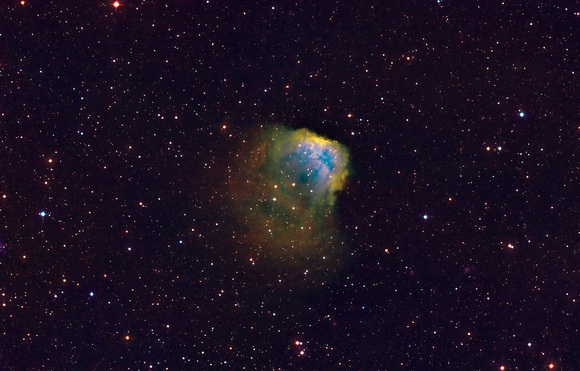ERGB1 - A Planetary Nebula.... or Not?
EGB1 (Ellis-Grayson-Bond 1) Planetary? Nebula (Cassiopia) in SHO (Hubble palette) with RGB stars
Planewave CDK12.5; AP 1100GTO AE ASI6200MM, - Antlia Pro RGB & 3.5nm NB filters Ha/O/S: (37,43,38 x 600s exposures, Bin 1x1, Gain 200) R,G,B: (35,21,21 x 120s, Bin 1x1, Gain 200) Total Integration Time = 22.2 hours – September 2023
EGB1 is a quite faint patch of nebulosity first discovered in the 1960s, however it wasn’t identified as an asymmetric planetary nebula until the 1980s, using Palomar Sky Survey prints.
At first, EGB1 appears as if it is passing through (invisible) interstellar media, causing one side to compress and the other to disperse – much like Sh2-188 (the Shrimp Nebula) of Sh2-68 (the Flaming Skull Nebula). However, a number of astronomers have proposed to determine if is actually the interstellar media itself that is the source of the emissions.
When imaged with RGB, EGB1 appears only as a faint red smudge in images. Additional details are revealed with an Ha filter. The [SII] narrowband signal is somewhat weaker than Ha, but yet much stronger than [OIII], making it rare unique for planetary nebulae, where the sulfur signal is almost absent.
Of course, a planetary nebula must contain a white dwarf star – both as a remnant of the progenitor star and as a source of energy for the emissions and EGB1 indeed has one. While not 100% confident that it is the officially recognized one, there is a small but bright star with a very blue halo near what would appear to be the centre of mass of the nebula. This star is not just a hot (class DA) white dwarf star, but also a variable star with a brightness period of 0.15 days (~ 3.5 hours). This may be indicating that the white dwarf is part of a binary star system.
Some planetary nebulae are very symmetric, while some show much more complex shapes. Having a multi-star core could set up both periodic tidal and radiation effects that result in more complex PN shapes, even when the nebula is relatively static with respect ot the interstellar medium. Whether this could also result in what appears to be a PN, but it actually just ISM is another question.
In any event, EGB1 does look a little different to me, almost as if a bubble is being blown out of funnel by the white dwarf star.


